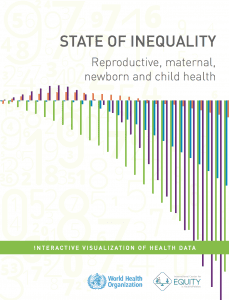New WHO report on “State of inequality: Reproductive, maternal, newborn and child health”
The report delivers both promising and disappointing messages about the situation in low- and middle-income countries. Within-country inequalities have narrowed, with a tendency for national improvements driven by faster improvements in disadvantaged subgroups.
However, inequalities still persist in most reproductive, maternal, newborn and child health indicators. The extent of within-country inequality differed by dimension of inequality and by country, country income group and geographical region. There is still much progress to be made in reducing inequalities in RMNCH.
Overall, inequalities were to the detriment of women, infants and children in disadvantaged population subgroups; that is, the poorest, the least educated and those residing in rural areas had lower health intervention coverage and worse health outcomes than the more advantaged. In a minority of cases, child health interventions or outcomes were unequal between boys and girls.
